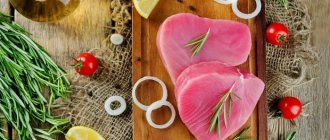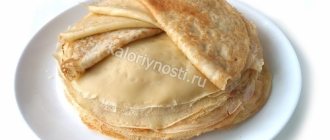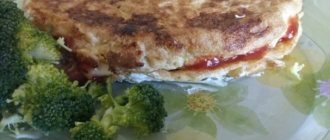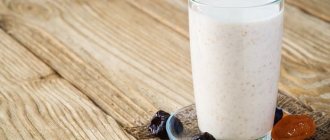Dietary properties:
How many calories are in tuna, what dietary properties it has, all this is of great interest to those who lead a healthy lifestyle and monitor their health and figure. So we will try to answer these questions in the next article.
So here it is:
In the seas of the tropics and subtropics there is a huge fish - tuna, which is one of the largest representatives of the mackerel family.
The meat of this fish has truly extraordinary taste, for which culinary experts have dubbed it “veal of the sea.”
Researchers from the Netherlands have proven through experiments that regular inclusion of this fish in the diet (at least 30 grams per day), due to its high content of the Omega-3 fat complex, halves the likelihood of developing cardiovascular diseases. It is a rich source of various microelements necessary for humans (for example, phosphorus, selenium, calcium, magnesium, iron), as well as vitamins and essential amino acids.
Eating this fish helps strengthen the immune system, helping the active synthesis of antibodies and reducing the risk of allergic reactions, it is useful for the rapid elimination of inflammatory processes, and can serve for the prevention of cancer. Tuna will also be useful for patients during treatment of cancer; it improves vision, protects us from depression and helps reduce pain from arthritis and arthrosis.
Calculation of caloric content of a product per 100 grams
The calculation of the calorie content of 100 grams of product is based on previously known indicators of BZHU (abbreviation: proteins-fats-carbohydrates). The calculation method is the summation of these data (obtained by laboratory analysis and calculations) previously multiplied by a value equal to the energy released (calories) during their splitting. So, for example, 1 gram of protein or carbohydrate can release energy equal to 4.1 kcal, and fat a little more than 9. In calorie calculations, these numbers are usually rounded to whole numbers, as is the result itself.
Our example involves proteins - 24.4 grams and fats - 4.6 grams, contained in 100 grams of product. Next we perform the calculation:
Energy value of 100 grams = 24.4 (proteins)*4 + 4.6 (fat)*9 = 97.6 + 41.4 = 139 kcal
Our calculated calorie content is more than 50, but less than 250 kcal, which means that tuna is a medium-calorie product with a high protein content, medium fat level and low carbohydrate content.
Recipe? Recipe!
How to cook this fish at home? Here is one of the recipes:
Tuna in tomato:
Products:
- Tuna -1 kg.
- Onions - 2 pieces
- Tomatoes -1 kg.
- Garlic - 2 cloves
- Wine (white) – ½ glass
- Oil, salt and pepper - to taste
- Breadcrumbs, parsley - also to taste
The fish is cleaned of bones and skin, salted and peppered. Then roll in flour and fry. Separately, lightly fry the chopped onion and garlic (in olive oil), and then add the tomatoes and simmer everything together until a thick mass is obtained. The resulting mass is wiped in a colander, salt, sugar, wine and spices are added to it - to your taste. This will give us the sauce.
Place the finished sauce on a heat-resistant tray, place pieces of fried tuna on top of the sauce, sprinkle everything on top with breadcrumbs and parsley and place the tray in the oven until browned. The fish is served on the table in the same tray.
Recipe Tuna baked in the oven. Calorie, chemical composition and nutritional value.
Nutritional value and chemical composition of “Oven-baked tuna.”
The table shows the nutritional content (calories, proteins, fats, carbohydrates, vitamins and minerals) per 100 grams of edible portion.
| Nutrient | Quantity | Norm** | % of the norm in 100 g | % of the norm in 100 kcal | 100% normal |
| Calorie content | 164.6 kcal | 1684 kcal | 9.8% | 6% | 1023 g |
| Squirrels | 29.2 g | 76 g | 38.4% | 23.3% | 260 g |
| Fats | 5.3 g | 56 g | 9.5% | 5.8% | 1057 g |
| Water | 65.8 g | 2273 g | 2.9% | 1.8% | 3454 g |
| Ash | 2.012 g | ~ | |||
| Vitamins | |||||
| Vitamin A, RE | 26 mcg | 900 mcg | 2.9% | 1.8% | 3462 g |
| Retinol | 0.023 mg | ~ | |||
| Vitamin B1, thiamine | 0.299 mg | 1.5 mg | 19.9% | 12.1% | 502 g |
| Vitamin B2, riboflavin | 0.251 mg | 1.8 mg | 13.9% | 8.4% | 717 g |
| Vitamin B6, pyridoxine | 1.001 mg | 2 mg | 50.1% | 30.4% | 200 g |
| Vitamin B9, folates | 7.802 mcg | 400 mcg | 2% | 1.2% | 5127 g |
| Vitamin E, alpha tocopherol, TE | 0.26 mg | 15 mg | 1.7% | 1% | 5769 g |
| Vitamin RR, NE | 20.1548 mg | 20 mg | 100.8% | 61.2% | 99 g |
| Niacin | 11.854 mg | ~ | |||
| Macronutrients | |||||
| Potassium, K | 405.05 mg | 2500 mg | 16.2% | 9.8% | 617 g |
| Calcium, Ca | 37.06 mg | 1000 mg | 3.7% | 2.2% | 2698 g |
| Magnesium, Mg | 36.28 mg | 400 mg | 9.1% | 5.5% | 1103 g |
| Sodium, Na | 80.94 mg | 1300 mg | 6.2% | 3.8% | 1606 g |
| Sera, S | 247.06 mg | 1000 mg | 24.7% | 15% | 405 g |
| Phosphorus, P | 353.2 mg | 800 mg | 44.2% | 26.9% | 227 g |
| Chlorine, Cl | 208.05 mg | 2300 mg | 9% | 5.5% | 1106 g |
| Microelements | |||||
| Iron, Fe | 1.183 mg | 18 mg | 6.6% | 4% | 1522 g |
| Yod, I | 65.02 mcg | 150 mcg | 43.3% | 26.3% | 231 g |
| Cobalt, Co | 52.012 mcg | 10 mcg | 520.1% | 316% | 19 g |
| Manganese, Mn | 0.169 mg | 2 mg | 8.5% | 5.2% | 1183 g |
| Copper, Cu | 130.03 mcg | 1000 mcg | 13% | 7.9% | 769 g |
| Molybdenum, Mo | 5.201 mcg | 70 mcg | 7.4% | 4.5% | 1346 g |
| Nickel, Ni | 7.802 mcg | ~ | |||
| Chromium, Cr | 117.03 mcg | 50 mcg | 234.1% | 142.2% | 43 g |
| Zinc, Zn | 0.9102 mg | 12 mg | 7.6% | 4.6% | 1318 g |
| Sterols (sterols) | |||||
| Cholesterol | 49.41 mg | max 300 mg | |||
| Saturated fatty acids | |||||
| Saturated fatty acids | 1.7 g | max 18.7 g | |||
| 14:0 Miristinovaya | 0.338 g | ~ | |||
| 16:0 Palmitinaya | 1.742 g | ~ | |||
| 17:0 Margarine | 0.169 g | ~ | |||
| 18:0 Stearic | 0.702 g | ~ | |||
| Monounsaturated fatty acids | 0.702 g | min 16.8 g | 4.2% | 2.6% | |
| 16:1 Palmitoleic | 0.403 g | ~ | |||
| 18:1 Oleic (omega-9) | 0.299 g | ~ | |||
| Polyunsaturated fatty acids | 0.546 g | from 11.2 to 20.6 g | 4.9% | 3% | |
| 20:5 Eicosapentaenoic acid (EPA), Omega-3 | 0.208 g | ~ | |||
| Omega-3 fatty acids | 0.5 g | from 0.9 to 3.7 g | 55.6% | 33.8% | |
| 22:5 Docosapentaenoic acid (DPA), Omega-3 | 0.052 g | ~ | |||
| 22:6 Docosahexaenoic acid (DHA), Omega-3 | 0.286 g | ~ |
The energy value of tuna baked in the oven is 164.6 kcal.
Primary Source: Created in the application by the user. Read more.
** This table shows the average levels of vitamins and minerals for an adult. If you want to know the norms taking into account your gender, age and other factors, then use the “My Healthy Diet” application.
What are the benefits of tuna for weight loss?
First of all, I would really like to note that eating this fish for dietary purposes is an excellent way to lose extra pounds without losing muscle mass. The fact is that in the process of losing weight it is very important not to completely lose fat in the diet, otherwise the body will not burn its own fat on the internal organs. Another thing is that during the diet you need to consume the right fats, which will stimulate the burning of internal excess reserves.
Tuna goes best with fruit vegetables (tomatoes, cucumbers, bell peppers) and leafy vegetables (lettuce, iceberg, Chinese cabbage). An excellent addition to the salad can be onions, a stalk of celery, green peas, corn, basil sprigs and pine nuts.
One condition is that diet dishes should not be seasoned with mayonnaise, even low-calorie ones; it is best to sprinkle them with lemon juice and pour a little olive oil over them. Only with this approach to nutrition will your figure soon become slim, your skin will become elastic, and your nervous system will be in perfect order.
Energy value (calorie content) of tuna
The energy value of tuna is average compared to other fish. The amount of calories in a product depends on two factors:
- what part of the fish is taken;
- how the product will be prepared.
From raw fish, fillets, steaks or shavings are obtained, and subsequently these parts, if necessary, are subjected to various methods of thermal or non-thermal processing. You can cook tuna in different ways. This product can be boiled in a pan on the stove, baked in the oven, fried in a pan or grilled, or steamed. Dried, smoked (hot and cold smoked), fresh, salted, canned tuna (in oil, in its own juice) is consumed as food.
© la_vanda – stock.adobe.com
What are the calories in different parts of tuna?
| Raw part of fish | Calorie content per 100 g | BJU |
| Steak | 131.3 kcal | 11.6 g protein, 2.9 g fat, no carbohydrates |
| Shavings | 434 kcal | 81.2 g protein, 1.8 g fat, 0.6 g carbohydrates |
| Fillet | 110 kcal | 23 g protein, 1.7 g fat, 0.2 g carbohydrates |
So, tuna flakes have the most calories, while the difference between fillet and steak is insignificant - only 19 kcal. Next, let's look at how the calorie content of a product differs depending on the method of its processing.
| View | Calorie content per 100 g | BJU |
| Boiled (boiled) | 141.2 kcal | 22.9 g protein, 1.9 g fat, no carbohydrates |
| Fried | 135.3 kcal | 21.9 g protein, 5.1 g fat, 0.1 g carbohydrates |
| Baked in the oven | 162.5 kcal | 28.1 g protein, 5.6 g fat, 0.8 g carbohydrates |
| Canned in oil | 188.4 kcal | 22.4 g protein, 9.9 g fat, no carbohydrates |
| Canned in its own juice | 103.4 kcal | 22.2 g protein, 1.3 g fat, 0.1 g carbohydrates |
| Smoked (cold smoked) | 138.2 kcal | 24.5 g protein, 4.4 g fat, no carbohydrates |
| Smoked (hot smoked) | 135 kcal | 22.5 g protein, 0.7 g fat, no carbohydrates |
| Grilled | 194.2 kcal | 21.3 g protein, 11.3 g fat, 0.6 g carbohydrates |
| For a couple | 123 kcal | 22.7 g protein, 1.3 g fat, 0.5 g carbohydrates |
| Fresh (raw) | 101 kcal | 23 g protein, 3 g fat, no carbohydrates |
| Salty | 139 kcal | 24.5 g protein, 4.5 g fat, no carbohydrates |
| Dried | 160.4 kcal | 34.4 g protein, 4 g fat, no carbohydrates |
The least high-calorie fresh tuna. Next comes canned fish in its own juice, while tuna canned in oil has much more calories.
For those who want to lose weight, steamed tuna is a must, because it only has 123 kcal. Take these indicators into account before eating any processed fish, especially if you adhere to proper nutrition.
More on the same topic:
Comments (1)
- LaskaS Writes, First of all, I would like to note that eating tuna for dietary purposes is a good way to get rid of excess weight without losing muscle mass. The fact is that when losing weight, it is very important not to completely exclude fats from the diet. Otherwise, our body will not break down its own fat in internal organs. But while adhering to a diet, you should consume the “right” fats, which will help burn excess internal reserves.
Useful properties of tuna
Dutch scientists conducted a series of experiments, as a result of which it was proven that daily consumption of 30 g of tuna halves the risk of cardiovascular diseases. The main, but far from the only, benefit of tuna is its high content of the Omega-3 fat complex.
The beneficial properties of tuna also include a high content of microelements, vitamins and essential acids necessary for the body. Regular consumption of tuna reduces the risk of allergic reactions, promotes the production of antibodies, fights inflammatory diseases, is useful for the prevention of cancer, relieves depression, and relieves pain from arthrosis and arthritis.

The benefits of tuna include stimulating metabolism and normalizing blood sugar levels. In addition, it helps remove cholesterol from the body, so doctors, despite the high calorie content of tuna, recommend consuming it for people suffering from obesity and hypertension. Tuna is especially useful for improving and restoring the properties of human skin and mucous membranes, in particular for eczema.
Tuna - calories
Tuna can hardly be called an ordinary guest on the table in the post-Soviet space. It is much easier to find it in the store in canned form than frozen or salted. Only exquisite Japanese cuisine, which uses it in sushi, rolls, and sashimi, helped many people discover the true taste of this fish. From this article you will learn how many calories are in tuna, and whether you can eat this product while losing weight.
Calorie content of fresh tuna
If you are lucky enough to find fresh tuna in the store, know that you can make some pretty tasty salads, appetizers, and main dishes from it. This type of fish is especially appreciated in the United States, where, due to the love of fast food restaurants (like McDonald's), a large part of the population is obese and strives to lose weight.
Tuna per 100 grams has a calorie content of only 139 kcal, and contains 24 g of protein and only 4 g of fat. This composition allows the product to be classified as dietary and included in the menu even during the period of weight loss.
It is worth noting that this type of fish is full of useful substances: it contains vitamins A, B, E, PP, as well as potassium, calcium, sodium, magnesium, iodine, chromium and fluorine. By eating it at least once a week, you will already bring considerable benefits to your body.
Much depends on which cooking method you choose. Avoid high-calorie marinades and frying - this way you will preserve all the beneficial properties of the product.
Calories in baked tuna
Tuna turns out amazing if you bake it in foil with spices. By the way, this delicacy is quite suitable for the dietary table: its calorie content is 187 kcal, of which 29 g of protein and 6 g of fat.
Do not forget that when eating dietary fish, you can ruin the matter with an excessively high-calorie side dish. For example, white boiled rice, potatoes or pasta are absolutely not suitable for a weight loss menu. It is better to choose brown rice, broccoli, zucchini, cabbage, and ideally, go for a side dish of fresh cucumbers and tomatoes.
Calories in canned tuna
Like all canned products, tuna loses a considerable part of its beneficial properties during such processing. Moreover, tuna is usually preserved in oil, which is why its calorie content soars to 232 kcal.
The composition of such a product is completely different from that of fresh tuna: there is 22 g of protein and 15 g of fat. Canned tuna is difficult to classify as a dietary product - it is more of a snack for those who naturally have a good metabolism.
Calorie content and nutritional value of canned tuna per 100 grams
Fresh fish is the most useful, but it is not always available, cannot be stored for a long time, and its price is high. Canned tuna may be a good choice. Calorie content and BJU depend on the presence of marinade, oil or other additives in the composition.
The following types of canned food can be distinguished (nutritional value is indicated per 100 grams):
- In its own juice. The most dietary - only 98 kcal, 22 grams of protein, 1 - fat.
- In oil. 232 kcal, 22 grams protein, 15.9 fat.
- For the salad. 88 kcal, 20 grams of protein, 0.4 - fat. It should be borne in mind that its reduced calorie content is due to the fact that the product contains additional water, skins, seeds, and other trimmings.
- Pate. The most high-calorie option: 17 grams of protein, 2.8 - carbohydrates, 27 - fat, energy value - 322 kcal.










